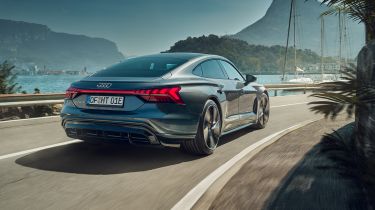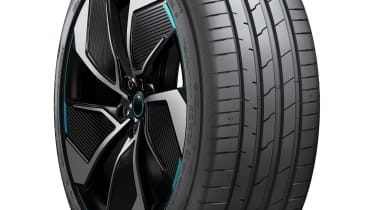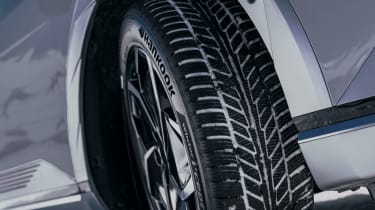5 reasons you need EV-specific tyres
The specific needs of an electric vehicle mean that for optimum performance, you need the right tyres
Electric vehicles are very different beasts compared to petrol and diesel-powered cars – so it pays to think differently when it comes to tyres.
That's why Hankook developed a new range of tyres to address all the specific needs of EVs, with the aim of improving both efficiency and performance.
But what are these EV demands? Let us take you through these challenges, and how the Hankook iON is able to solve them.
1. Noise reduction
Normally, the sound of an engine does a good job of drowning out tyre noise. Replace it with one or more motors, however, and reducing the roar of four tyres making contact with the road becomes a lot more important.
To do this, Hankook iON tyres feature Sound Absorber™ technology. This involves a special material inside the tyre to reduce what's known as 'cavity noise', while the inner tread grooves are knurled to combat tread noise.
Also, the size and shapes of the tread blocks are varied, so they don't contact the road in a uniform manner. This stops the tyres from emitting a drone as they rotate at speed.
2. Rolling resistance
With charging an EV still being a relatively time-consuming experience, it’s important to make each charge last as long as possible.
By reducing rolling resistance, iON tyres can increase your EV's efficiency, improving its range. This is done mostly through the make-up of the rubber itself.
Each iON tyre is made with Hankook's EVolution compound, which uses high-concentration silica and various eco-friendly materials for lower rolling resistance and longer tyre life. Prolific use of natural oils meanwhile means less material needs to go into the tyre, leading to a weight reduction of up to one kilogram per tyre. A lighter tyre is easier to turn, so this helps rolling resistance even more.
3. Air resistance
Reducing rolling resistance is just one way a tyre's efficiency can be improved - iON tyres are also carefully optimised to cut through the air as cleanly as possible. The tread pattern has been designed for better airflow, and even the lettering on the sidewalls is designed for the best aerodynamic efficiency.
4. Weight
Electric vehicles are on average 25-30 per cent heavier than the equivalent petrol or diesel-powered car, thanks largely to the hefty battery packs they use.
This puts extra strain on the tyres, so the iON S and SX summer tyres use reinforced belts containing aramid fibres. This is a super strong material often found in body armour, which helps the iON keep its shape when under load, so more of the tyre stays in contact with the tarmac.
There's an EV-specific 'contour' for the tyre, too, giving a 10 per cent increase in stiffness when cornering, and all tyres in the range are built for the top XL (extra load) rating.
4. Instant torque
EVs are known for being able to deliver their torque outputs – which are often significant – instantly. This puts yet more stress on the tyre while it already deals with the typical extra EV weight. To prevent wheelspin, iON tyres use extended outer shoulder blocks of tread, providing more rigidity and a better contact patch with the road.
Sizes and types
The European iON range covers four different categories and a variety of sizes to accommodate many current EV models. The iON S is a summer tyre, coming in nine sizes from 18 to 21 inches in diameter, while for SUVs there’s the iON SX in 14 sizes from 18 to 22 inches.
Joining the range in September 2022 will be the iON winter tyre. This will be sold in 13 sizes from 18 to 21 inches, while the iON X SUV winter tyre will come in 23 sizes from 18 to 22 inches.
Tyre jargon explained
Blocks: Raised blocks of rubber that make contact with the road surface.
Compound: The mix of ingredients that makes up tyre rubber.
Ribs: Bands of tread blocks that run around the circumference of the tyre.
Groves: The gaps between the ribs that run around the circumference of the tyres.
Pitch frequency: The shapes and sizes of the tread blocks, which can be varied to avoid the tyre making a monotonous droning noise
Contour: The shape of the tyre which determines how round or flat it is. Flatter is better for wear and performance but generally worse for ride comfort and noise.
Rolling resistance: The friction that occurs between the tyre and the tarmac as the wheels turn. Reducing this can boost efficiency and tyre life.
Find a car with the experts






